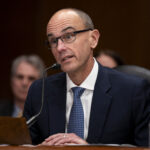Personal auto insurance premiums grew 10 times faster for direct writing carriers than for independent agency carriers in 2011, according to a new study.
The newly-released “2013 Property & Casualty Insurance Market Share” study published by the Independent Insurance Agents & Brokers of America (Big “I”) revealed the continued dominance of exclusive (captive) agency writers over both independent agency carriers and direct writers in the personal auto market. But while there was virtually no personal auto premium growth for either group of agency writers in 2011, direct writers recorded a 7.5 percent increase in direct premiums written, the study showed.
The study summarizes growth for 2011 because that was the last complete year of data available for the study, the Big “I” report said, revealing that the premium information was provided by A.M. Best. The report, which also gives a historical perspective of 17 years of market share changes for the different distribution channels, notes that carriers writing through independent agents still control a majority of the overall property/casualty insurance market. In fact, agency writers held 57 percent of all P/C insurance premiums written in 2011, also capturing the lion’s share of the commercial lines market.
Independent agents dominate over all other distribution systems in commercial lines, with more than three-quarters of commercial premiums written going to agency carriers. According the report, independent agents also place one-third of all personal lines premiums.
The challenge in the personal auto line remains a concern and opportunity for the independent agency channel, says Madelyn Flannagan, co-author of the Big “I” report.
Regional independent agency carriers fell slightly in market share in personal auto from 26.4 percent in 2010 to 26.3 percent in 2011, Flannagan said. National carriers lost more. “They’ve dropped down from 7 percent of the market to 6.7 percent of the (personal auto) market,” she said. “Those are insignificant percentages, but they represent billions of dollars in premiums.”
That premium is moving straight to the direct response channel, she said.
The study indicates that direct response accounted for 17.4 percent of the personal auto insurance market in 2011, compared to 7.7 percent in 1995—the first of the 17 consecutive years studied by Big “I.” Total personal auto insurance premiums for direct response writers were $29.3 billion in 2011.
Direct response carriers managed to grow personal auto premiums by $2 billion in 2011, according to the report. “That’s a significant amount of money in this marketplace,” Flannagan said. “Certainly, independent agents have got a lot of work to do to make up their losses.”
According to the report, overall premiums for national and regional agency writers totaled $55.7 billion in 2011, almost unchanged from 2010. Exclusive agency companies garnered $81.8 billion, commanding 48.4 percent of the market, but like the independent agency writers, recorded almost no growth in direct written premiums in 2011.
In the other personal lines market studied—homeowners—all channels experienced premium growth in 2011, but here it is the regional agency carriers that are gaining market share at the expense of captive writers. According to the study, the market share of regional agency carriers for homeowners was nearly 26 percent in 2011, compared to 22 percent 17 years earlier. Over the same timeframe, exclusive agency companies saw market share fall to 51 percent from 56 percent.
The report presents similar analyses of market share and premium growth for commercial lines overall, and for workers’ compensation and commercial auto.
For more details of the study, and a podcast interview of Ms. Flanagan by Insurance Journal’s Andrea Wells, see related article, Agents Hang Onto P/C Market But Lose Ground in Personal Auto: Study and visit www.InsuranceJournal.tv.
(A version of this article was originally published on Wells Media’s sister publication, Insurance Journal. Andrea Wells is Editor In Chief of Insurance Journal.)




















 McKinsey Plots Thousands of Job Cuts in Slowdown for Consulting Industry
McKinsey Plots Thousands of Job Cuts in Slowdown for Consulting Industry  AI in Property/Casualty Insurance: Why Trusted Data Is the Missing Link
AI in Property/Casualty Insurance: Why Trusted Data Is the Missing Link  Odometer Fraud Sees 14% Jump in the Past Year
Odometer Fraud Sees 14% Jump in the Past Year  Insurance Industry ‘Megadeals’ Dominate 2025, Says PwC
Insurance Industry ‘Megadeals’ Dominate 2025, Says PwC 




